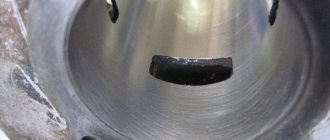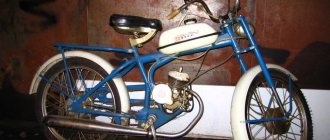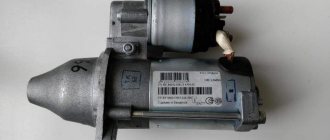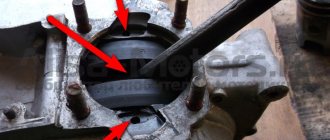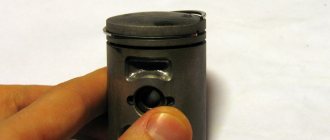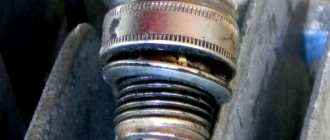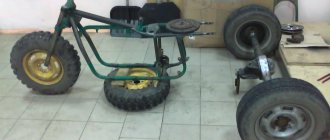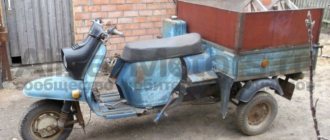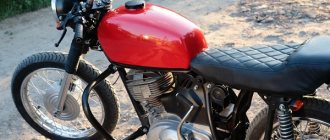Change or repair the cylinder?
The time inevitably comes when your motorcycle, previously so playful and obedient, becomes lazy during acceleration and does not pull up the hill in direct gear, which it previously took off like a bird.
Replacing the piston rings seems to help, but only for a short time. Soon the smoke from the exhaust pipes becomes even thicker, fuel consumption increases - and along with it the power is supplied. And it becomes finally clear: the cylinder needs to be repaired. But first you should carefully measure the cylinder, obtain data on its dimensions and true configuration, and determine the type of repair. However, sometimes it doesn’t even come to measurements. It is enough to inspect the cylinder mirror. If there are deep scuffs or vertical scratches on it, and this is observed when the piston or retaining rings break, or the retaining pins fall out, the cylinder must either be replaced with a new one or bored to the repair size of the piston. In this case, the boring depth will depend on the depth of the scratches or the available piston.
Boring is an operation performed on a lathe. It is not very complicated and does not require extremely high qualifications. The main thing in it is to maintain perpendicularity to the axis of the cylinder and its base. And to do this, you first need to prepare a faceplate, make holes in it for the studs or bolts for securing the cylinder, align it to the plane with a cutter and bore it to the size of the cylinder neck. Without changing the position of the faceplate in the chuck, the cylinder should be secured to it in the same way as it is attached to the crankcase, and only then bored.
Attempts to simplify the operation, to carry out boring in three- or four-jaw chucks without a faceplate, are, as a rule, doomed to failure: after boring, the mirror in those places where the jaws compressed it “moves away” from the desired geometric shape and becomes oval.
Rice. 1. Homemade hone for a 125 cm3 class cylinder : 1 - blank; 2 - spring; 3 - abrasive block.
After boring, in order to bring the cylinder surface to a mirror state, another operation is needed - honing . In Fig. Figure 1 shows a homemade hone for the cylinders of Minsk motorcycles. This is a wooden block with a diameter of 51 mm and a height of 140 mm, having one central hole and four vertical grooves. Rectangular spring-loaded abrasive bars are inserted into the grooves; A long bolt is passed through the hole, by means of which the hone is secured in the chuck of the drilling machine. A hone for any other cylinder can be made in the same way. If the cylinder is fixed rigidly, then any spindle runout will lead to a violation of the geometric shape of the mirror. To prevent this from happening, you only need to hold the cylinder with your hands.
By setting the hone to a rotation speed of 200-220 rpm and providing 30-60 reciprocating strokes during the same time, the slight allowance left after boring is gradually removed and the surface is improved. To speed up the work, you can use bars with a grain size of 150-170 at the beginning, and 250-400 at the end. During operation, it is necessary to generously and continuously moisten the bars and mirror with kerosene and periodically check the size.
Let's return, however, to the beginning of the article. Let's imagine that our cylinder has no defects visible to the naked eye.
The most convenient way to measure the cylinder diameter is with an indicator bore gauge. Measurements must be taken in the two outer zones, 10-15 mm from the upper and lower ends of the cylinder, as well as in the middle of the stroke of the piston rings. In each belt, two measurements are taken: in the plane of swing of the connecting rod and perpendicular to it.
After taking all the measurements and recording them on a plate, you will see that the numbers are different in all zones and in all planes. The cylinder became oval, barrel-shaped and conical. And that's why. The load on its walls from the piston side is greater in the plane of swing of the connecting rod, perpendicular to the piston pin. Consequently, the wear of the cylinder in this plane will be greater than in the perpendicular one. Hence the ellipse: the diameter in the pin plane of a well-worked cylinder is noticeably smaller than in the perpendicular one.
The loads on the cylinder wall and in the very plane of the connecting rod’s swing are not uniform. The largest cylinder perceives approximately in its middle part. If we take into account that the cylinder of a two-stroke engine in this zone is completely “perforated” with inlet, exhaust and purge windows, and in the remaining area the specific pressure is significantly higher than it would be at full, it becomes clear that it is in this zone that the most significant abrasion of the metal occurs : barrel-shape appears,
The main causes of taper are the effects of piston rings and so-called gas corrosion. The meaning of these phenomena is that during the power stroke, gases formed during fuel combustion penetrate into the piston grooves and increase the pressure of the rings. As the piston moves downward, the gas pressure drops and this “additive” to the normal elasticity of the ring decreases, the pressure of the rings on the walls weakens. In this regard, the cylinder in the upper part wears out more than in the lower part.
Well, what about our measurements?
If their results show that the increase in diameter in the worst case for a 125–200 cm3 class cylinder is 0.15–0.20 mm, and for a 350 cm3 class is 0.2–0.25 mm, we can confidently say that the cylinder needs renovation.
As for the taper, it can be determined in a simpler way: using any piston ring. You need to insert it into the cylinder and measure the gap in the lock in the upper and lower chords already known to you. Divide the difference between these values by 3.14 - and you get the generally accepted expression for taper. If your midday value exceeds 0.06-0.08 mm (smaller value for smaller cubic capacity) - the cylinder can no longer be used. By the way, in the same way, in extreme cases, all other measurements of the cylinder can be carried out.
Honing is not suitable for repairing conical, oval or barrel-shaped cylinders, since the abrasives in the hone are movable and follow the cylinder walls. To eliminate these types of wear, there is another repair method. It's called lapping.
Often lapping is used instead of honing as the final operation after boring, but you can generally replace boring with lapping. True, this stretches the process, but gives good results.
Rice. 2. Expanding lap for 125 cm3 cylinder : 1 - body; 2 - split bushing; 3 — washer; 4 - bolt; 5 - cut in the sleeve.
The working tool is an expanding lap (Fig. 2). Its body 1 is usually made of steel, bushing 2 is made of fine-grained cast iron with a hardness of HB 140.
First, the sleeve blank is machined (its length is from 100 to 150 mm, depending on the volume of the cylinder), leaving an allowance along the outer diameter and finally processing the inner conical hole. After this, the workpiece is either cut along the axis with one through pass of a hacksaw (mills, see Fig. 2), or four non-through cuts are made: two on one side and two on the other side, not bringing them about 20 mm to the end (Fig. 3) . After this, a body is made, at the outer end of which a hole is drilled and a thread is cut for an M12-M14 bolt, as shown in Fig. 2, or leave the shank and cut a thread on it, as shown in Fig. 3. The sleeve is placed on the body, secured with a bolt and finally machined to the size of the cylinder minus 0.1 mm. Lapping can be carried out in a drilling machine.
Rice. 3.Example of lapping with four cuts.
Apply lapping paste - abrasive powder mixed with oil - to the outer surface of the bushing and put on the cylinder. As with honing, the cylinder cannot be secured - you just need to hold it with your hands. Spindle revolutions, as a rule, are 50-80 per minute, vertical movements - 30-60 per minute. From time to time it is useful to turn the cylinder over - this ensures more uniform processing. You often have to prepare the lapping paste yourself - by rubbing two identical abrasive bars against each other. We have already talked about graininess above. Finish the treatment with polishing pastes and an empty GOI.
Recently, special sets of grinding pastes in tubes have appeared on sale, the production of which was launched by the Poltava plant of artificial diamonds and diamond tools named after the 50th anniversary of the USSR. They cost 3 rubles and fully meet our needs.
When, during operation, the lap begins to rotate freely in the cylinder, the bolt or nut should be tightened so that this rotation becomes tight. Periodically, you need to stop the machine and wash the cylinder and the lap, removing accumulated dirt and processing products. After finishing work, the cylinder is thoroughly washed with kerosene and warm water and soap. Control is carried out directly on the piston, under which the cylinder is ground.
V. KHALNOV, engineer
1988N01P31
Measurements
We buy a new piston, one repair size larger (usually 1 unit) and see how and where it fits (if it doesn’t fit, then there’s still more to come
).
We push in different directions to understand where and what is in the way. If the cylinder worked in risky modes, it means it has a huge output. Mine worked with too early ignition, a slightly lean mixture, which gave quite high revolutions.
The cylinder mirror is excellent, but here's the breakdown:
What you see on the cylinder liner is dirt. That is, a lubricant that once was. After removing it, I preserved it for some reason. I don’t know why.
Having measured the piston (even if it goes inside, it jams right in the middle), I realized that it needs to sharpen just a little. If the piston doesn’t fit at all, then yes, let’s see how much grinding needs to be done. Usually in such situations they sharpen 0.1-0.15 mm. I sharpened 0.01-0.07. It is advisable to choose a piston in the store so that it barely enters. Then boring will turn out better because you can pick up the piston even larger and bore it again. In the pictures there is simply a worn-out cylinder that seems to have served its useful life during this repair.
You've been waiting for this for so long, let's start the process.
Five random articles about motorcycles:
Return conditions and procedure
All purchased goods presented in our store are subject to the manufacturer’s warranty, subject to the Buyer’s compliance with the operating instructions.
When receiving motorcycle spare parts, you need to check the product for visible defects, otherwise complaints about the appearance of the product that are discovered later will not be accepted. When returning or exchanging goods, the Buyer must have with him a receipt of payment confirming the fact of purchase of the goods. The product must retain its presentation, original packaging and consumer properties. The buyer must notify the seller by email or telephone of his intention to exchange or return the product. Auto parts without boxes and without fasteners (bolts or nuts, centering rings) if included, depending on the configuration, are not accepted for return. Guaranteed obligations... Read more >>
Java problems - 638 (characteristic “sores”)
What hurts the Jawa 638 - the most common problems among Jawa 638 owners: In order to evaluate the new JAVA model (Jawa 638), we must remember the shortcomings of the previous one: weak six-volt electrical equipment, chronic undercharging of the battery, low-capacity tool boxes and ever-leaking front fork seals.
All these “bottlenecks” have been successfully “embroidered” in the new model with index 638. The motorcycle has a rational and finished appearance. The new saddle, which is 50mm wider and 70mm longer, is much more comfortable than the previous one. Unfortunately, few kind words can be said about the engine, which, although it contains successful design discoveries, has serious shortcomings. In general, today among motorcyclists it is generally accepted that the best engine is the ChZ-350 (CZ-350) model “472-6”, which combines the reliability of the Jawa 634 and a 12V generator. The Java 638 engine is well built. Its lightweight aluminum cylinders with well-developed fins cool well... Read more >>
Electrical diagram Java 634
Electrical equipment Jawa 634 (Click on the picture to enlarge) 1— main headlight lamp (6 V, 35+35 W);
2— parking light lamp (6 V, 4 W); 3— direction indicator lamp (6 V, 15 W); 4— lamp for monitoring generator operation (6 V, 2 W); 5 — high beam warning lamp (6 V, 2 W); b — speedometer lighting lamp (6 V, 2 W); 7 - central switch; 8 — turn signal interrupter relay; 9 — sound signal; 10 — switch for low-high beam with a button for turning on the sound signal; 11 — turn signal switch; 12 — capacitors; 13 and 14 — contacts of the ignition interrupter of the left and right cylinders; 15 and 16 — spark plugs; 17 — ignition coils; 18 — brake light switch; 19 — relay-voltage regulator; 20 - battery (6 V, 14 Ah); 21 - generator (6 V, 75 W); 22 - fuse (15 A); 23 - stop lamp... Read more >>
40000 km to Java 634-8-00
CORRECT BREAK-IN IS THE KEY TO DURABILITY IN A COLD ENGINE WITH INTENSIVE WEAR HIGH SPEED - IT IS EASIER TO MAINTAIN THE ENGINE - YOU REPAIR LESSLY When purchasing a motorcycle of a new brand, a person is naturally interested in everything that concerns this machine.
What should you pay attention to when running in, what are the features of driving and maintenance, what is the durability of the main components and assemblies, etc.? These questions are often found in letters from readers. The answers to them are contained in the material published here about the Jawa-350, but much of it is also true for other motorcycles with a two-stroke engine (Voskhod, IZH, etc.). It was prepared by an experienced motorcyclist, consultant to the magazine, engineer E. Konop. We started operating the Jawa-350 type 634 model 8-00 four years ago, rode in a wide variety of conditions, under various loads, in all imaginable modes. Then, in the spring of 1977, the JAVA we took out of the box was no different from many others that were in the mother’s yard... Read more >>
What do Jawa 634 and CZ 472 have in common?
For those who ride Java and ChZ Many readers - owners of Czechoslovak motorcycles Java and ChZ face certain difficulties, especially when operating them in rural areas.
The reasons are their own inexperience, lack of specialized literature, and mainly that these motorcycles, intended mainly for paved roads, are often used in places where they have to travel quite a lot on unpaved roads. We selected the questions most often found in editorial mail and asked engineer E. KONOPA to answer them. What parts of the new and old JAVA are interchangeable? What do the YAVA-634 and ChZ-472 motorcycles have in common? It is impossible to completely list all the interchangeable parts and assemblies in the article. Let's focus on the main ones. In the new Java 634 motorcycle engine, the compression ratio is higher, achieved by reducing the height of the cylinder. The remaining main dimensions - landing and center-to-center - are the same, which makes it possible to install a new crank into an old engine... Read more >>
login registration forgot your password?
Motorcycle goods store About the store Terms and return procedure
How to bore a cylinder at home on a scooter
In this article I wanted to explain to many, based on many years of experience, that boring a scooter cylinder and honing it (or, as people more simply call it, grinding) are two different processes, and doing only one of them is in 100% cases money down the drain.
Unfortunately, a lot of workshops that repair scooters do not even delve into the essence of these processes; as a rule, they either have a makeshift grinding machine or an old USSR machine with grinding bars. Or do people simply hand over the cylinder for grinding without even asking what they will do? how will they do it? on what equipment, etc.
Often in practice, when replacing a piston or when changing piston rings, they work with so-called honing brushes or spring-loaded honing stones. However, this action has little in common with proper sprouting and honing. In this case, the more or less worn-out working surface of the scooter cylinder is only cleaned and made a little rough. This cannot improve the geometric characteristics of the cylinder. Due to the fact that the grinding tools are loaded with spring force, they precisely follow every deviation from roundness and every misalignment, but still without improving the geometry of the cylinder . Due to the lower contact pressure, it is unlikely that sufficient surface roughness can be achieved to improve lubrication. As a result, there is greater frictional resistance for the new piston rings, which wear into the cylinder wall a little faster. Thus, this wear on the cylinder surface cannot be prevented or reduced. If the piston rings are worn, then, based on experience, the cylinder wall is equally worn. The remarkable appearance of the internal bore after simple honing of the cylinder should not be misleading, since the ellipse of the cylinder remains the same.
